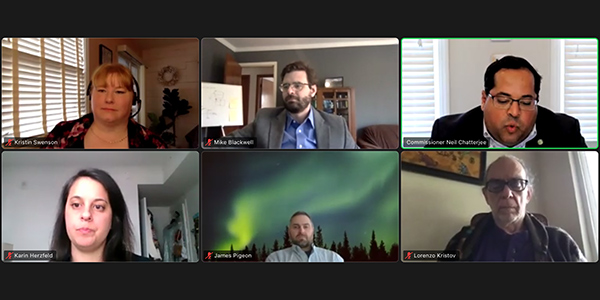The upcoming RTO stakeholder processes on Order 2222 are “where the rubber meets the road” for distributed energy resources’ participation in the markets, FERC Commissioner Neil Chatterjee told an Energy Bar Association webinar Wednesday.
Chatterjee was the FERC chair in September when the commission issued Order 2222, which directed RTOs to open their capacity, energy and ancillary service markets to aggregated DERs. (See FERC Opens RTO Markets to DER Aggregation.)
The order requires RTOs to allow DER aggregators to register as market participants under models that accommodate their physical and operational characteristics. FERC defines DERs as any resource located on the distribution system, a distribution subsystem or behind a customer meter, including energy and thermal storage, intermittent and distributed generation, energy efficiency and electric vehicles.
Chatterjee said the RTO compliance processes would be “interesting to watch” because, like Order 841, “we baked into the order a fair amount of flexibility on certain issues.” Compliance filings are due July 19. (See related story, MISO to Seek Extension on Order 2222 Plan.)
“For example, we provided some flexibility for each region to determine the locational requirements for DERs to participate in an aggregation,” said Chatterjee, the webinar’s keynote speaker. “As another example, we require each RTO to establish rules that address the requirements related to metering and the hardware and software necessary for DER aggregations to participate, recognizing that there’s always a push and pull between technical needs and the potential burdens on new market participants that they create.”
Chatterjee noted a projection that there will be almost 19 million EVs on U.S. roads by the end of the decade. “But the truth is those EVs will be off the road more than they are on the road,” he said. As charging infrastructure develops, he said, EVs will be “virtually able to work in concert to provide grid-level services.”
“That’s an easy way to think about the potential of Order 2222, but the true beauty of the rule is that it’s technology-neutral,” Chatterjee added. “So as new technologies emerge, our market rules will be able to accommodate them.”
Chatterjee said that when he visited the National Renewable Energy Lab in Colorado in October, he learned the scientists had been tracking Order 2222. “They viewed it as a catalyst for the work they’re doing on new technologies for the clean energy transition,” Chatterjee said. “It was deeply gratifying to know that our work at the commission was driving such significant change.”
Panel Discussion
Following Chatterjee’s keynote, a panel discussed approaches among RTOs for Order 2222 compliance, market impacts of DER proliferation, jurisdictional issues relating to DER adoption, and the impact of DERs on grid reliability and resilience.
“It’s striking to me the brilliance of how this [order] is written,” said Tricia DeBleeckere, planning director in the Minnesota Public Utilities Commission’s regulatory analysis division. “Whatever outcome or however this order plays out, it’s going to get what FERC’s intention is, which is a path for DERs to a market, whatever that market might be.”
Lorenzo Kristov, an independent consultant and former principal at CAISO, emphasized that the coordination between DER aggregators, utilities and RTOs is “really going to be crucial to both having efficient competition and also increasing participation in the wholesale market by DERs.”
FERC attorney Karin Herzfeld said the commission needed to recognize the interests state and local regulatory authorities have in Order 2222, which “actually requires the RTOs and ISOs to coordinate with all of these entities.”
“I think that the role provided to distribution utilities and their view of the aggregations is going to be huge,” Herzfeld said. “That’ll be a big thing that the stakeholder processes will be wrestling with in the near future.”
Chatterjee, whose term ends in June, said it would be an “understatement” to say he was proud of Order 2222.
“To me, the beauty of Order 2222 is its simplicity,” Chatterjee said. “Don’t get me wrong. I fully understand that the details underpinning the rule, and the compliance work that stakeholders are engaged in right now with the RTOs, is hugely complex.”
Chatterjee said at the core of the order is a “rather simple and elegant premise.”
“We should eliminate any hurdles facing DER aggregations in our markets, so they can line up and compete with traditional resources to provide all the energy and ancillary services and capacity that they have to offer.”




